Need
for Transposition of Over Head Transmission Lines
Effect
of Transposition
1. The
transposition in transmission line will balance the capacitance of the line, so
that the electrico-statically induced voltages balanced in the length of a
complete set of transposition.
2. It
also decereses electromagnetic induced emfs on the wires.
3. By
proper coordination of transposition of power and communication lines, the
induced voltages can be reduced to very small and also it reduced the noise in
the communication lines.
Calculation
of inductance in a transposed line
Conductors are transposed in 3 phase systems, when
they are irregularly spaced. Then for purpose of calculations, the may be
treated as thorough the conductors were spaced symmetrically at an equivalent
delta spacing of D = where D1, D2,
and D3, are the spacing between the conductors as shows in fig````
Capacitance
of a single phase line
Let A and B represent two round parallel conductors
of radius “r” each and are displaced at a distance “d” m apart.
If +q is the charge per unit length of conductor A
and –q is the charge per unit lenth of conductor B induced by A as shown in
fig. 1.20.
Then intensity at point P due to A=











0 Comments